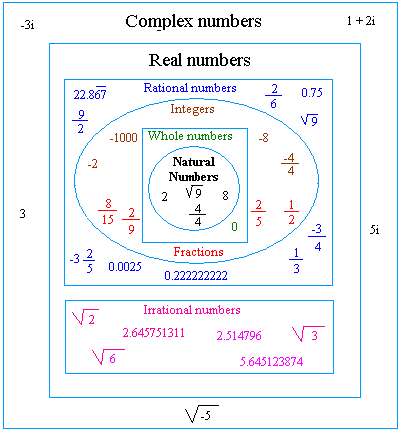We addressed 3 topics in class yesterday.
First thing first, number classification. The chart below gives the classifications as well as some examples.

Complex numbers encompass all other groups. It has two divisions: real and imaginary. Imaginary numbers includes figures such as the square root of a negative number. Real goes further.
Real then into rational numbers and irrational numbers. Rational numbers either repeat after the decimal or terminate. Irrational numbers do not.

Rational numbers divide into integers, which consist of negatives, 0, and positives. Integers also contains whole numbers (-1, 0, 1, 2 ,3, etc.) and natural numbers, which are the numbers we use to count. (1, 2, 3, 4, etc.)
Secondly, it would make most sense to discuss properties.
The commutative property seems like a good place to start. It states that only when operation multiplication or addition, any order of the numbers yield the same outcome. The same is NOT true of SUBTRACTION or DIVISION.

if we were subtracting a from b, it would not yield the same result of b-a unless both variables were zero.
Next is the associative property.

It just states that grouping doesn't make a difference with multiplication and addition, but again, DOES NOT WORK WITH SUBTRACTION OR DIVISION.
To prove anything, you must use variables, so...
(a+b) +c= a+b+c
a+(b+c)= a+b+c
a(b*c)= abc
(a*b)c= abc
Distributive property.

ONLY WORKS WITH MULTIPLICATION.
A picture is worth one-thousand words, no?
Identities:
Ladies and gentlemen, this man is Joseph Ducreux, a 17th century painter most famous for painting Queen Elizabeth's portrait, but is otherwise known as an unorthodox self-portrait painter. But that is not the kind of identity we are talking about.
Identities are used for operations where you want a number to remain the same on both sides of the equation.
The additive and subtractive identity is 0.
245-0=245
245=0=245
The MULTIPLICATIVE (MUL-TI-PLIC-A-TIVE) and divisive identities are 1.
245/1=245
245*1=245
Another thing:
Identities can be acquired in an equation in different ways, depending on the operation. For addition or subtraction, you add it's opposite. (useful for factoring)
For multiplication, you multiply a number by it's reciprocal. (1 over the original number as a denominator)
and for division, simply divide a number by its self.
AND I THINK THAT'S ABOUT IT.
I do look forward to another fantastic adventure in Mr. Wilhelm's class, and would like to take a poll from the class.

It's in great conditon, 14000 miles, 2001, 1000cc engine.
Should I get this? And if so, should I paint it yellow so it looks like my moped grew up into a big, strong, sports bike?
That's all.
Shane Mc
P.S.
This may sound corny, but every day is only as good as your attitude towards it.
No comments:
Post a Comment